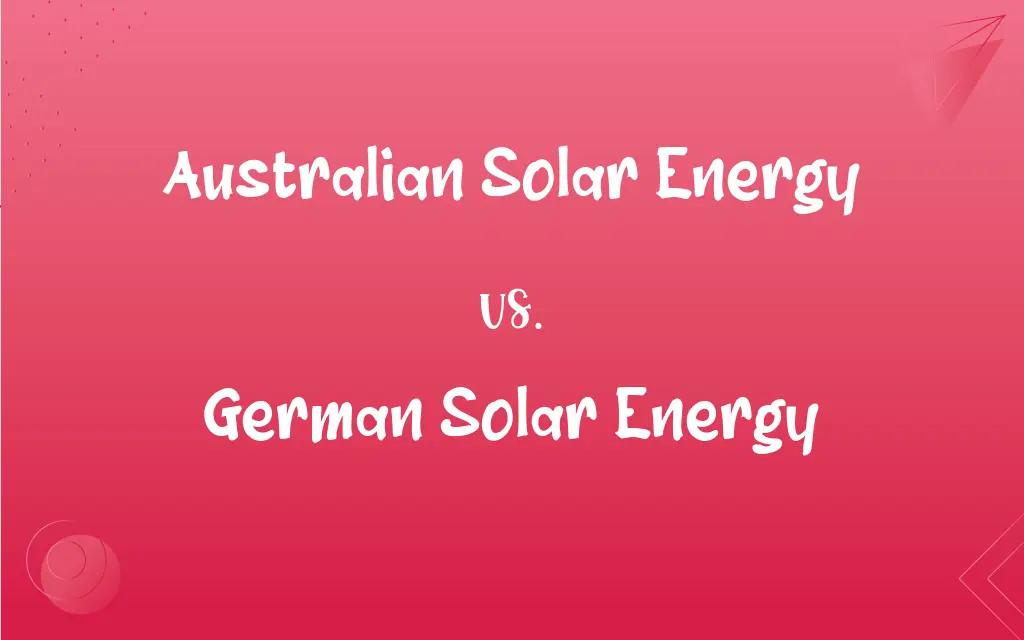Australian Solar Energy vs. German Solar Energy: What's the Difference?
Edited by Aimie Carlson || By Harlon Moss || Updated on October 26, 2023
Australian solar energy pertains to solar power developments and use in Australia, while German solar energy relates to solar initiatives and applications in Germany.

Key Differences
Australian solar energy refers to the harnessing of solar power in the vast and sun-rich landscapes of Australia. In contrast, German solar energy speaks to Germany's ambitious solar endeavors despite having less sunlit days than many other countries.
While Australia has a natural advantage with its sunny climate, giving it immense potential for solar energy generation, German solar energy has seen significant advances due to technological innovations, policy incentives, and community participation.
Australian solar energy has witnessed a surge, especially in household solar panel installations, given its conducive climate and vast land area. Conversely, German solar energy has long been a leader in the global solar industry, emphasizing not just domestic usage but also exporting solar technology.
The dynamics driving Australian solar energy largely stem from its need to shift away from coal and a growing public interest in renewable resources. Meanwhile, German solar energy is rooted in the country's broader commitment to "Energiewende" or energy transition, moving away from fossil fuels to sustainable sources.
Both Australian solar energy and German solar energy symbolize their respective country's steps towards a more sustainable future. However, while Australia taps into its natural solar abundance, Germany showcases the power of innovation and policy in promoting solar energy.
ADVERTISEMENT
Comparison Chart
Geographical Advantage
High sunlight exposure.
Less sunlight, yet highly efficient solar utilization.
Policy and Incentives
Increasing, with a focus on shifting from coal.
Long-standing, integral to "Energiewende".
Technology & Export
Growing industry, mainly domestic use.
World leader, significant exporter of solar tech.
Public Participation
Rising household installations.
High public and community involvement.
Challenges
Intermittency, energy storage.
Integration with grid, maintaining efficiency.
ADVERTISEMENT
Australian Solar Energy and German Solar Energy Definitions
Australian Solar Energy
Sun-powered developments in the Australian continent.
Desert areas offer prime locations for Australian solar energy farms.
German Solar Energy
Germany's leap towards a sun-powered future.
German solar energy contributes significantly to the nation's renewable energy mix.
Australian Solar Energy
Australia's push towards clean, sun-derived energy.
The increase in Australian solar energy installations has reduced dependency on coal.
German Solar Energy
Germany's commitment to a brighter, sustainable tomorrow.
German solar energy policies have set global standards in promoting renewables.
Australian Solar Energy
The renewable shift in the Australian energy landscape.
Australian solar energy is reducing the nation's carbon footprint.
German Solar Energy
The fusion of technology and sustainability in Germany.
German solar energy projects are benchmarks in efficiency and innovation.
Australian Solar Energy
Solar power initiatives in Australia.
Australian solar energy projects are on the rise, especially in its sunlit regions.
German Solar Energy
Solar innovations from the heart of Europe.
With its advanced technologies, German solar energy systems are sought after worldwide.
Australian Solar Energy
Harnessing the sun's power down under.
With its abundant sunlight, Australian solar energy potential is vast.
German Solar Energy
Solar power endeavors in Germany.
Despite its cloudy days, German solar energy initiatives are globally renowned.
FAQs
What characterizes Australian solar energy?
Australian solar energy is characterized by its vast potential due to abundant sunlight and vast landscapes.
Is German solar energy mainly domestic?
While domestic use is significant, German solar energy also emphasizes exporting technology and expertise.
How has Germany excelled in solar energy?
German solar energy thrives due to innovative technologies, strong policies, and public participation.
Does Australian solar energy face challenges?
Yes, like intermittency and the need for energy storage solutions.
What's the future of Australian solar energy?
It's promising, with ongoing investments, research, and a push for renewables.
Are there many solar farms in Australia?
Yes, the number of solar farms in Australia is increasing, tapping into the country's immense solar potential.
How does the Australian solar energy market compare globally?
Australia's solar market is growing rapidly, making it one of the leading nations in solar energy per capita.
What environmental benefits does Australian solar energy bring?
It reduces carbon emissions, decreases reliance on fossil fuels, and contributes to a cleaner environment.
How does German solar energy fit into the broader European energy landscape?
German solar energy is a cornerstone of Europe's renewable energy efforts, influencing policies and practices across the continent.
Is German solar energy a part of a bigger initiative?
Yes, it's integral to Germany's "Energiewende" or energy transition plan.
What role do communities play in German solar energy?
Communities play a pivotal role, often investing in and owning local solar projects in Germany.
How does German solar energy impact its economy?
It boosts the economy by creating jobs, reducing energy costs, and exporting solar products.
Does Australian solar energy focus on residential or commercial sectors?
Both, but there has been a significant rise in residential solar panel installations in recent years.
What are the main drivers behind German solar energy's success?
Technological innovations, supportive policies, and public participation have driven German solar energy's success.
Is Australian solar energy primarily used for electricity?
Yes, the primary use is electricity generation, but it's also used for heating and other applications.
Are there research initiatives in Germany for advancing solar energy?
Absolutely, Germany invests heavily in research to further improve solar technologies and integration.
How do Australians view solar energy?
There's growing interest, with many households opting for solar panel installations.
Are there government incentives for Australian solar energy?
Yes, various federal and state incentives promote the adoption of solar energy in Australia.
How does Germany's climate affect its solar energy?
Despite less sunlight, German solar energy excels due to technological efficiency and strong policies.
How has German solar energy influenced other countries?
German solar energy, with its policies and technologies, has set benchmarks for other countries to emulate.
About Author
Written by
Harlon MossHarlon is a seasoned quality moderator and accomplished content writer for Difference Wiki. An alumnus of the prestigious University of California, he earned his degree in Computer Science. Leveraging his academic background, Harlon brings a meticulous and informed perspective to his work, ensuring content accuracy and excellence.
Edited by
Aimie CarlsonAimie Carlson, holding a master's degree in English literature, is a fervent English language enthusiast. She lends her writing talents to Difference Wiki, a prominent website that specializes in comparisons, offering readers insightful analyses that both captivate and inform.































































